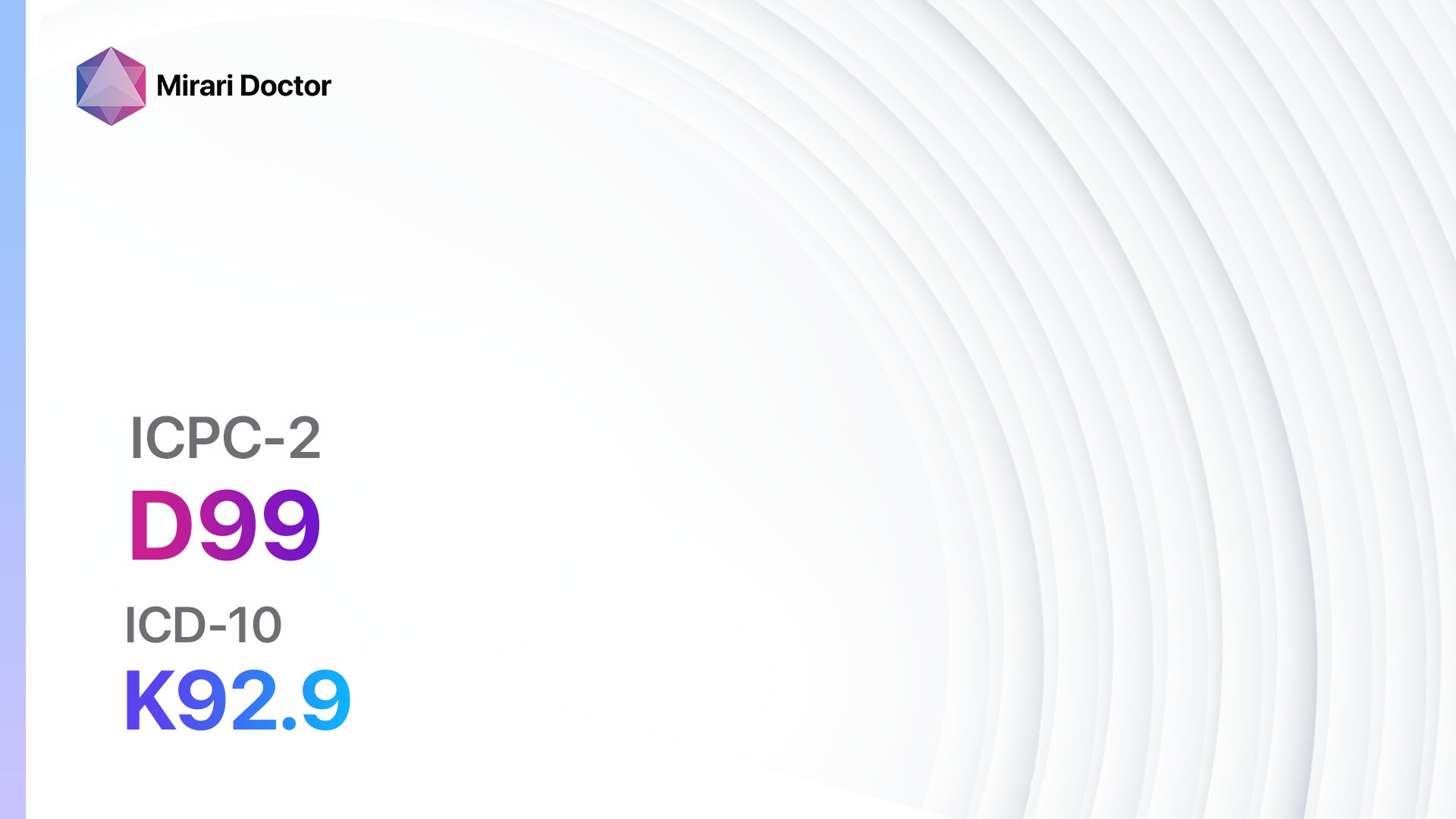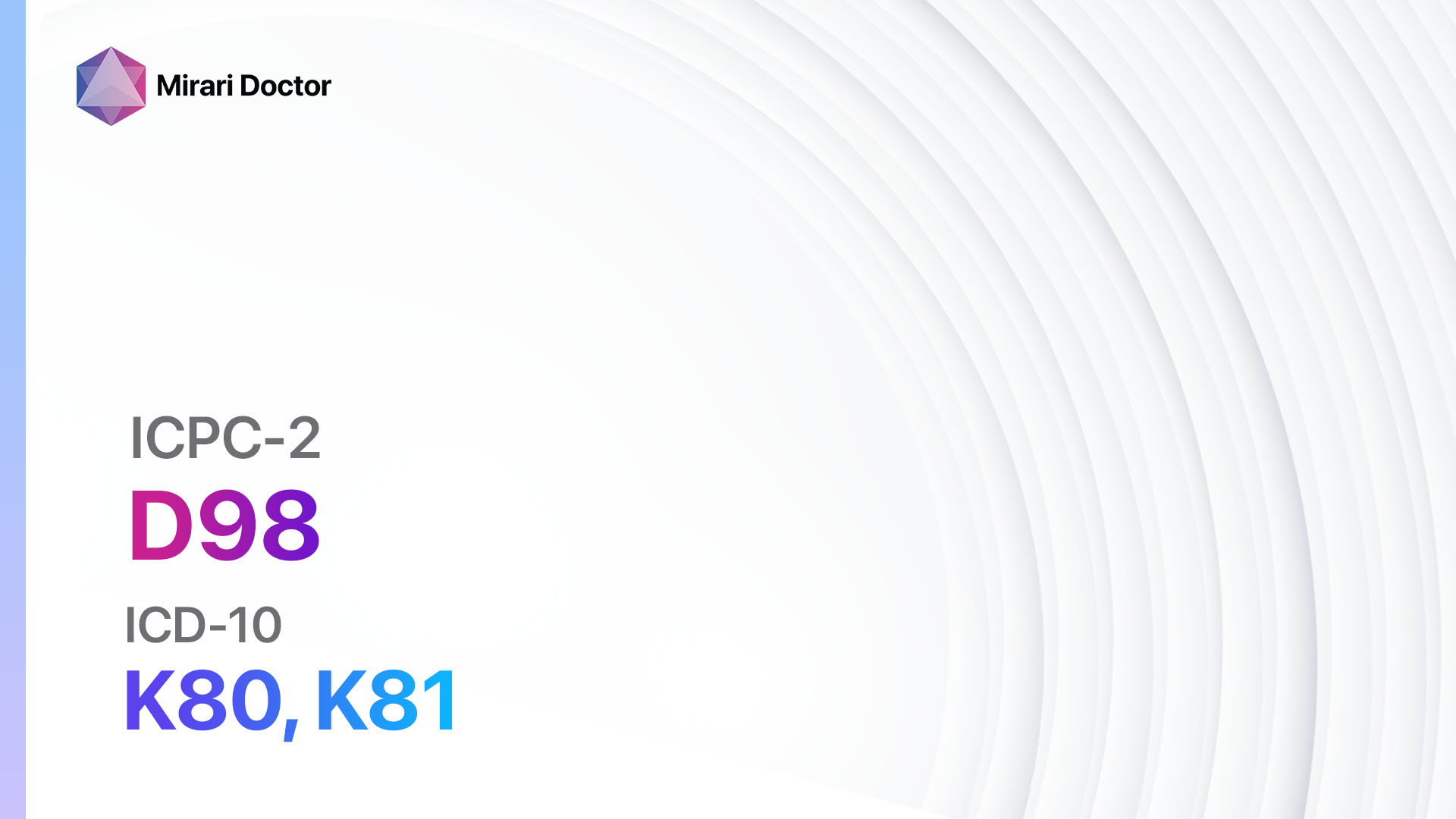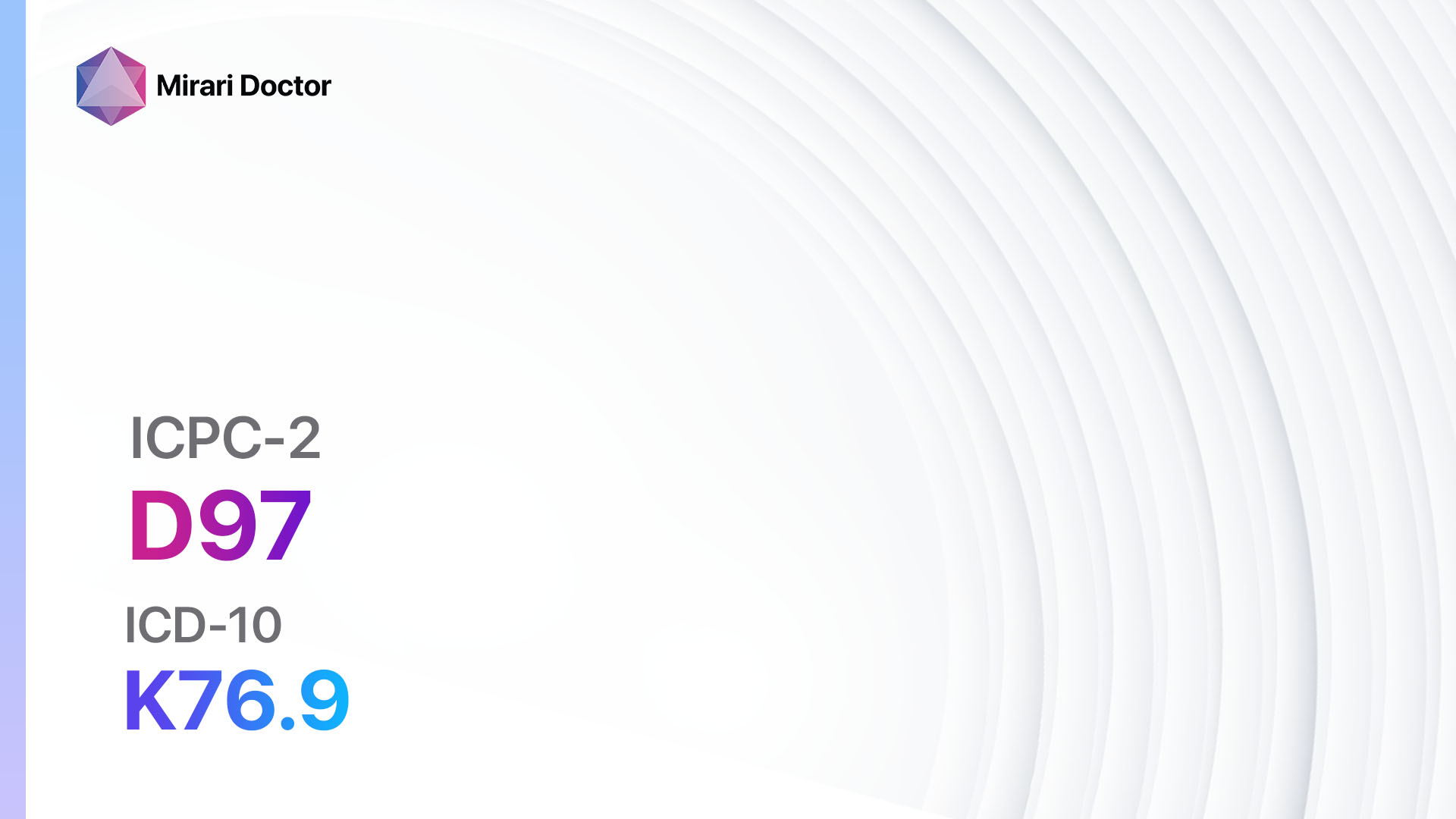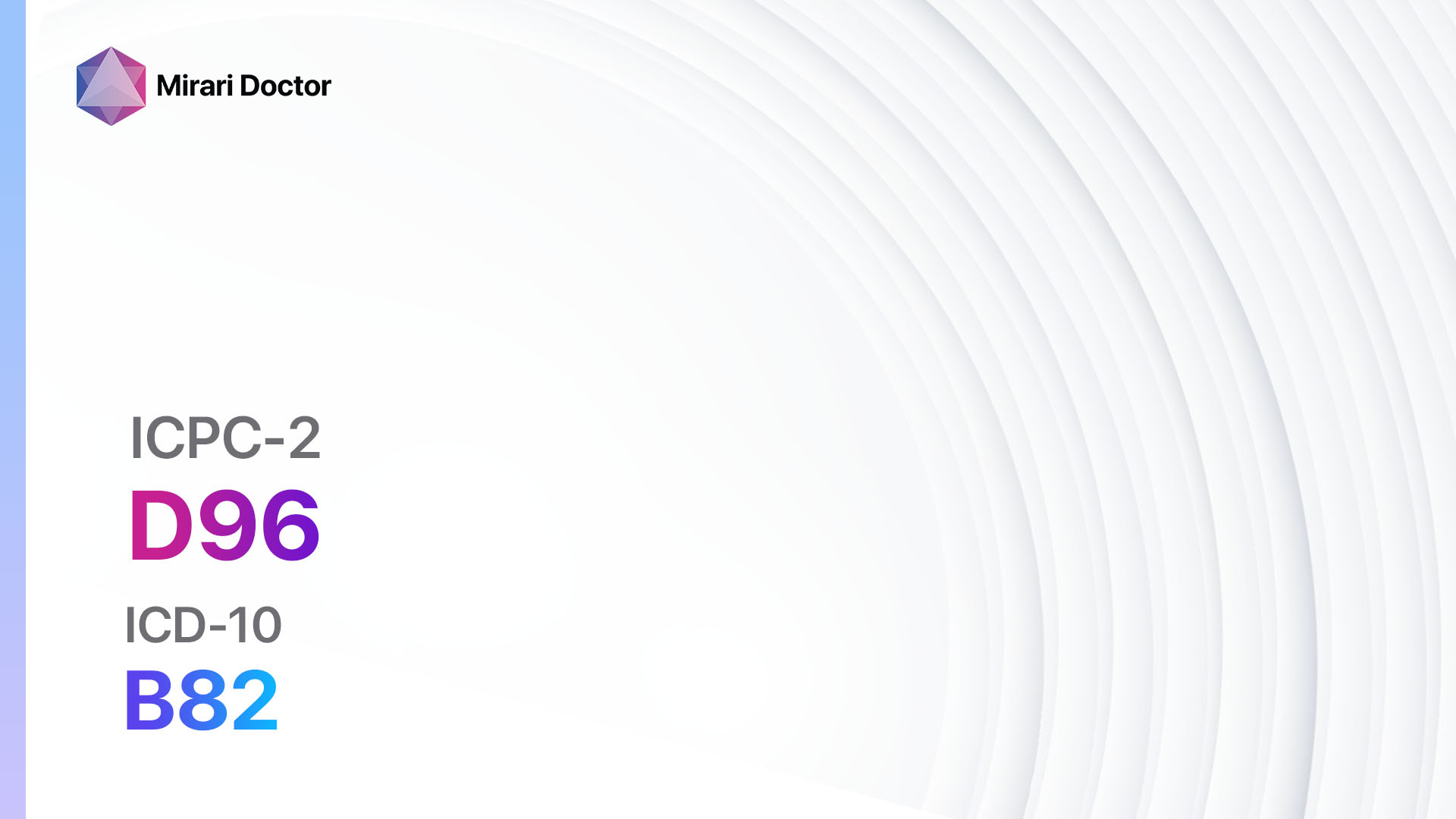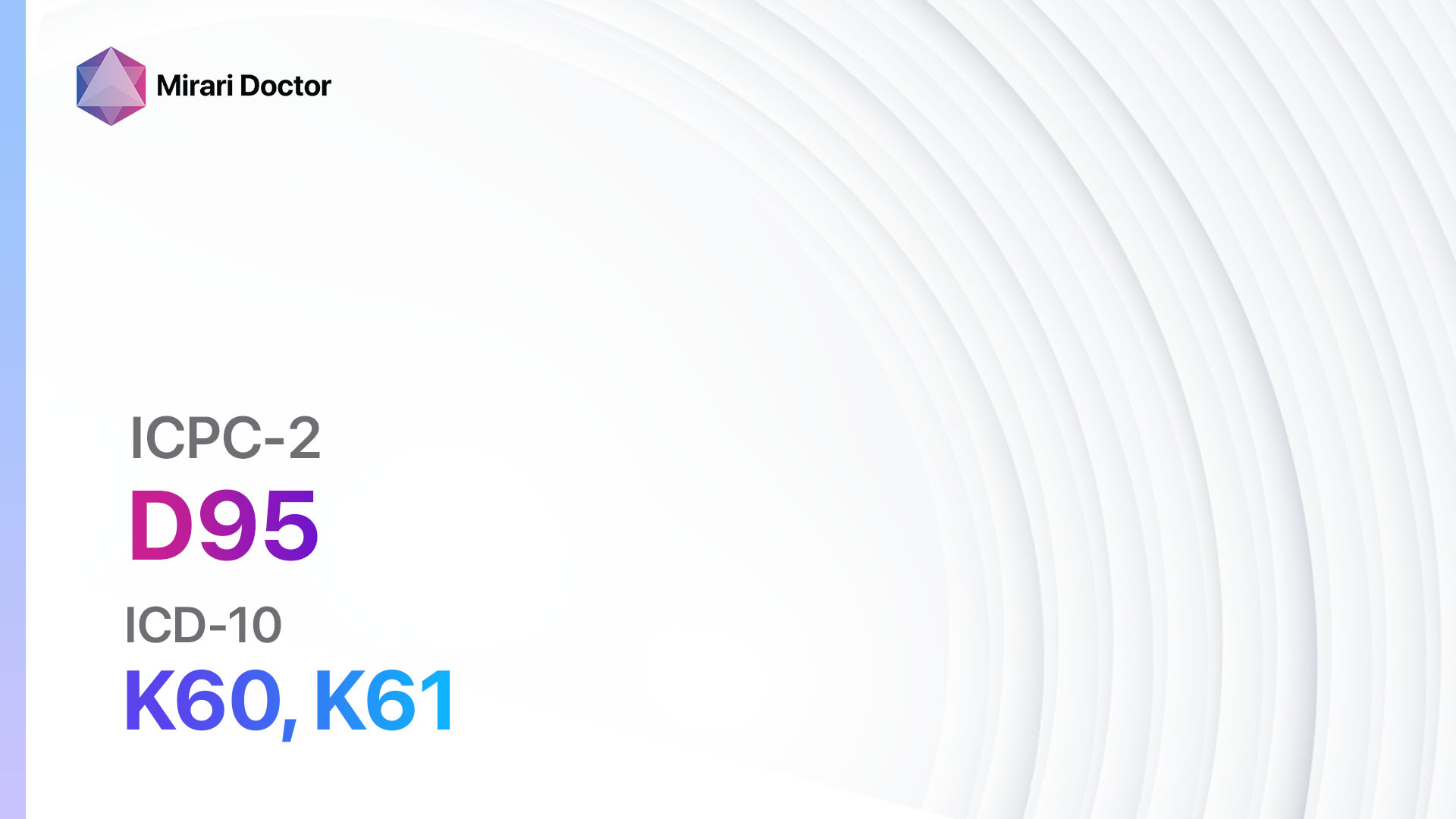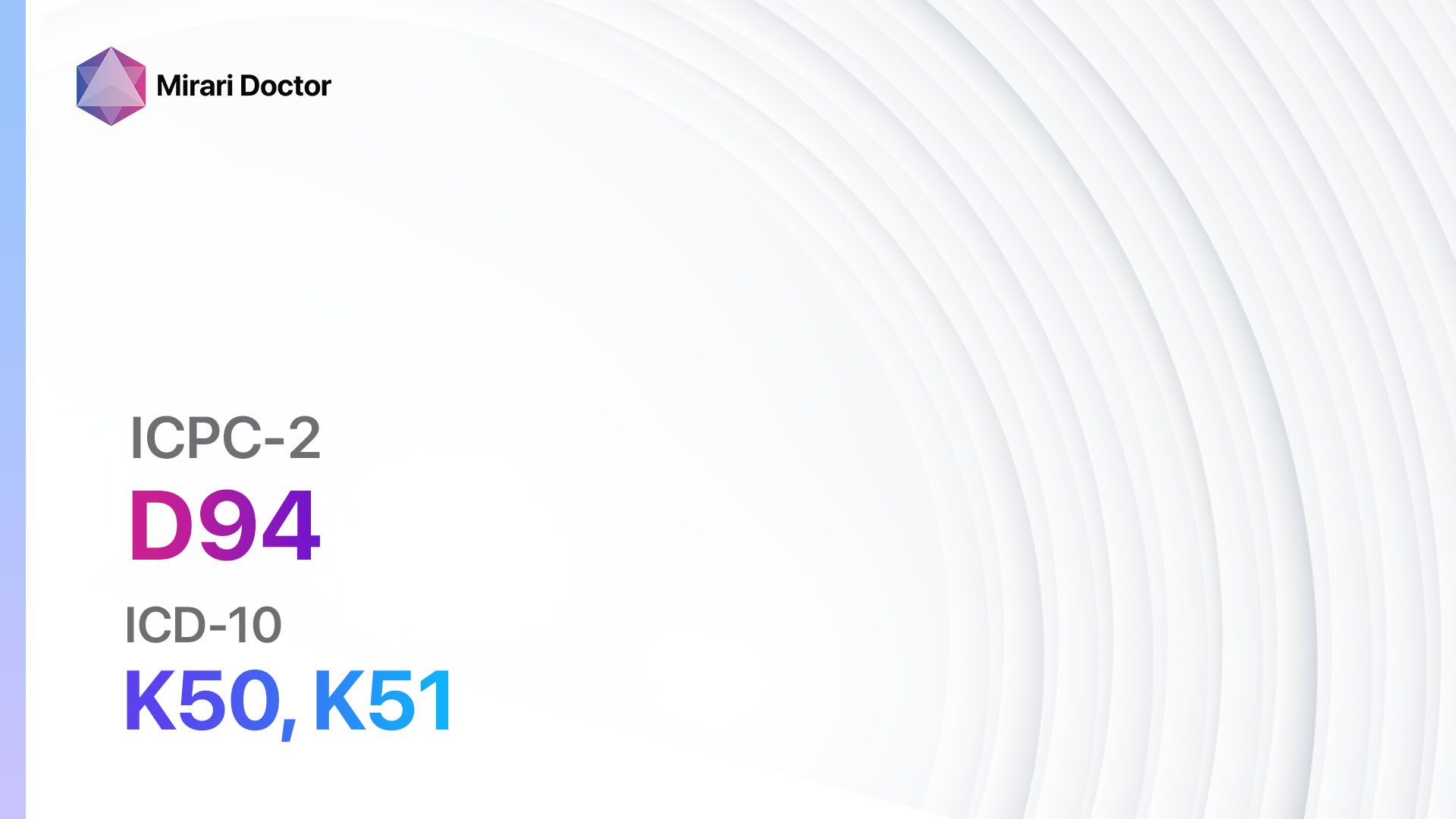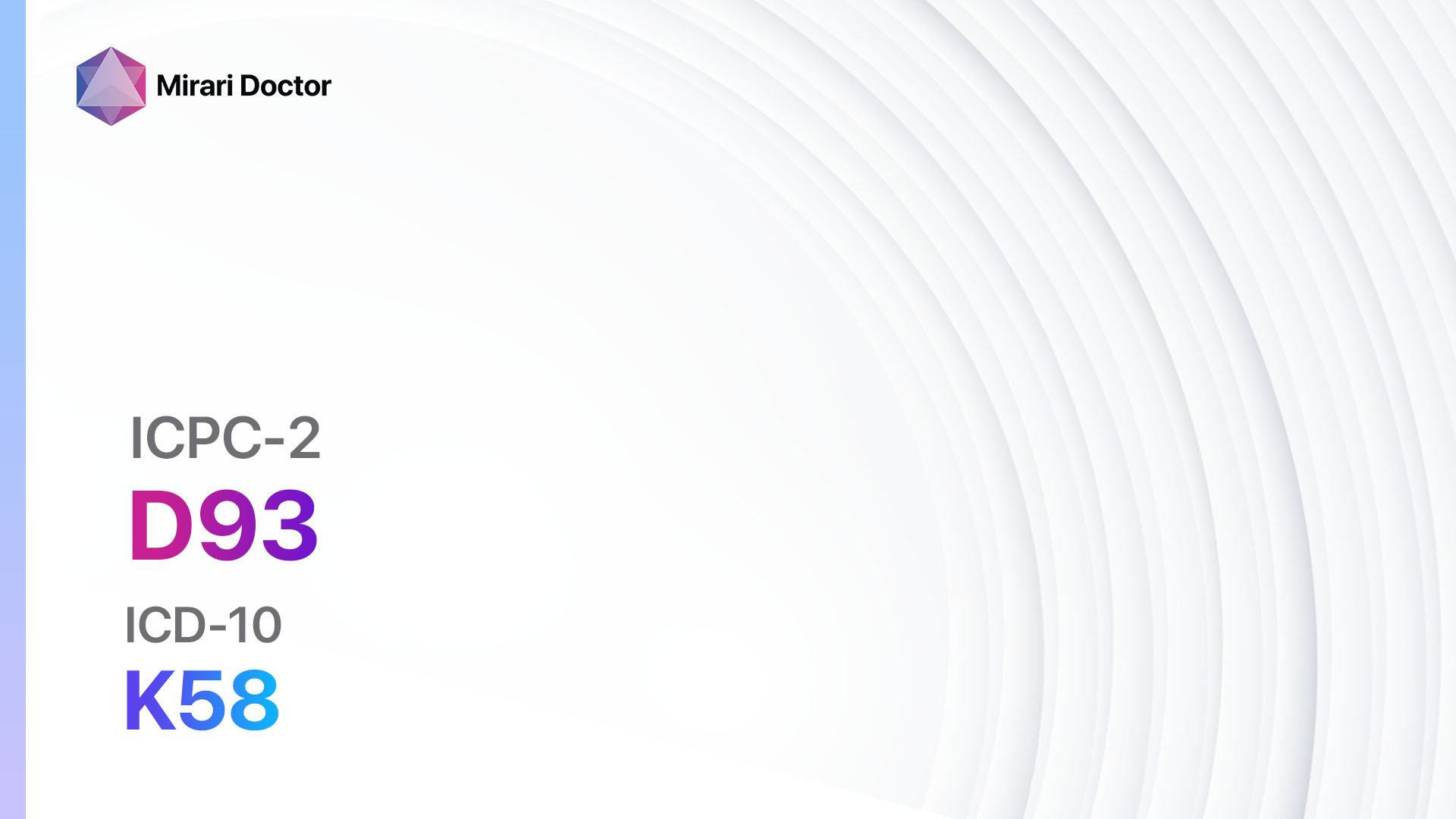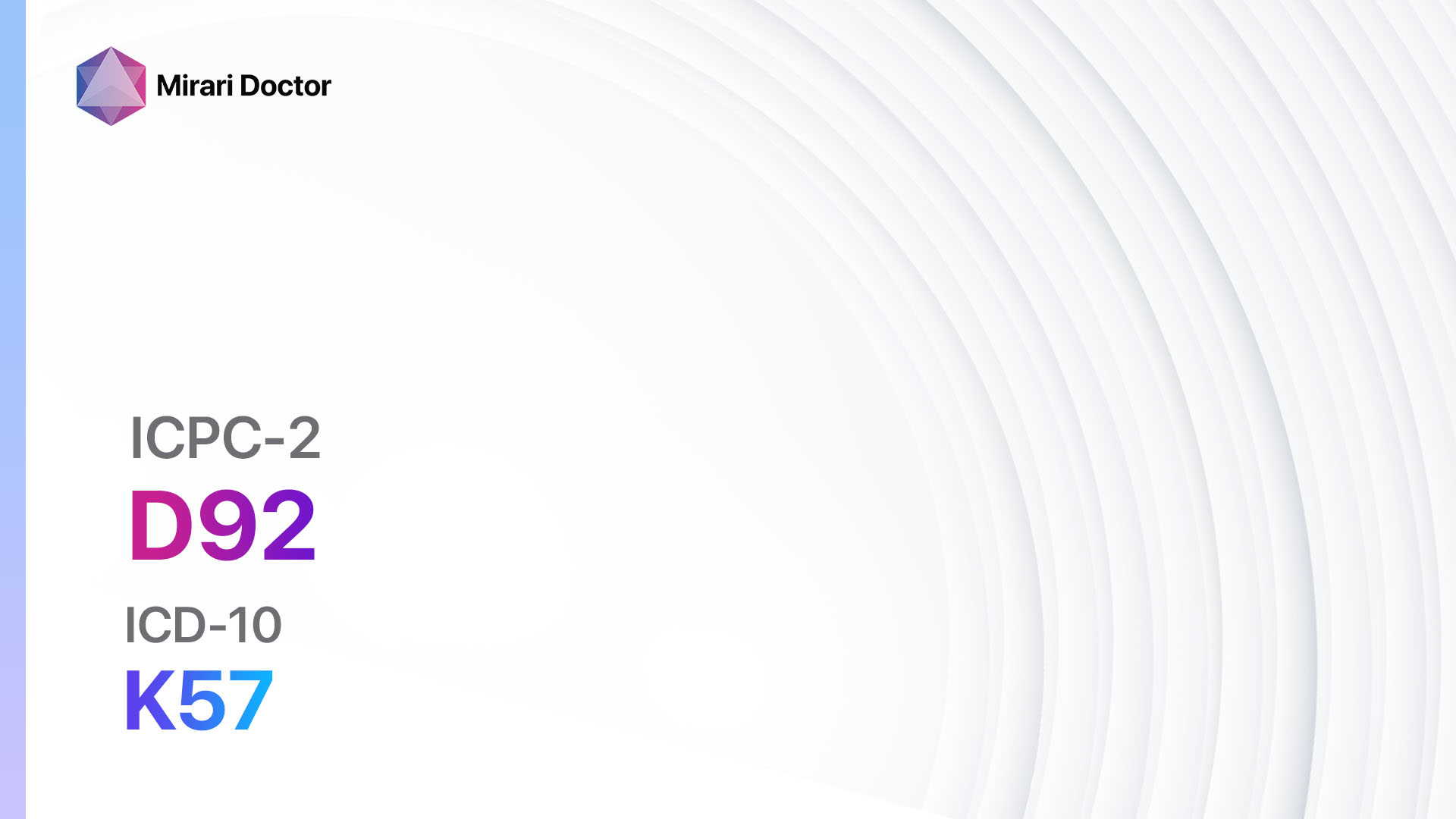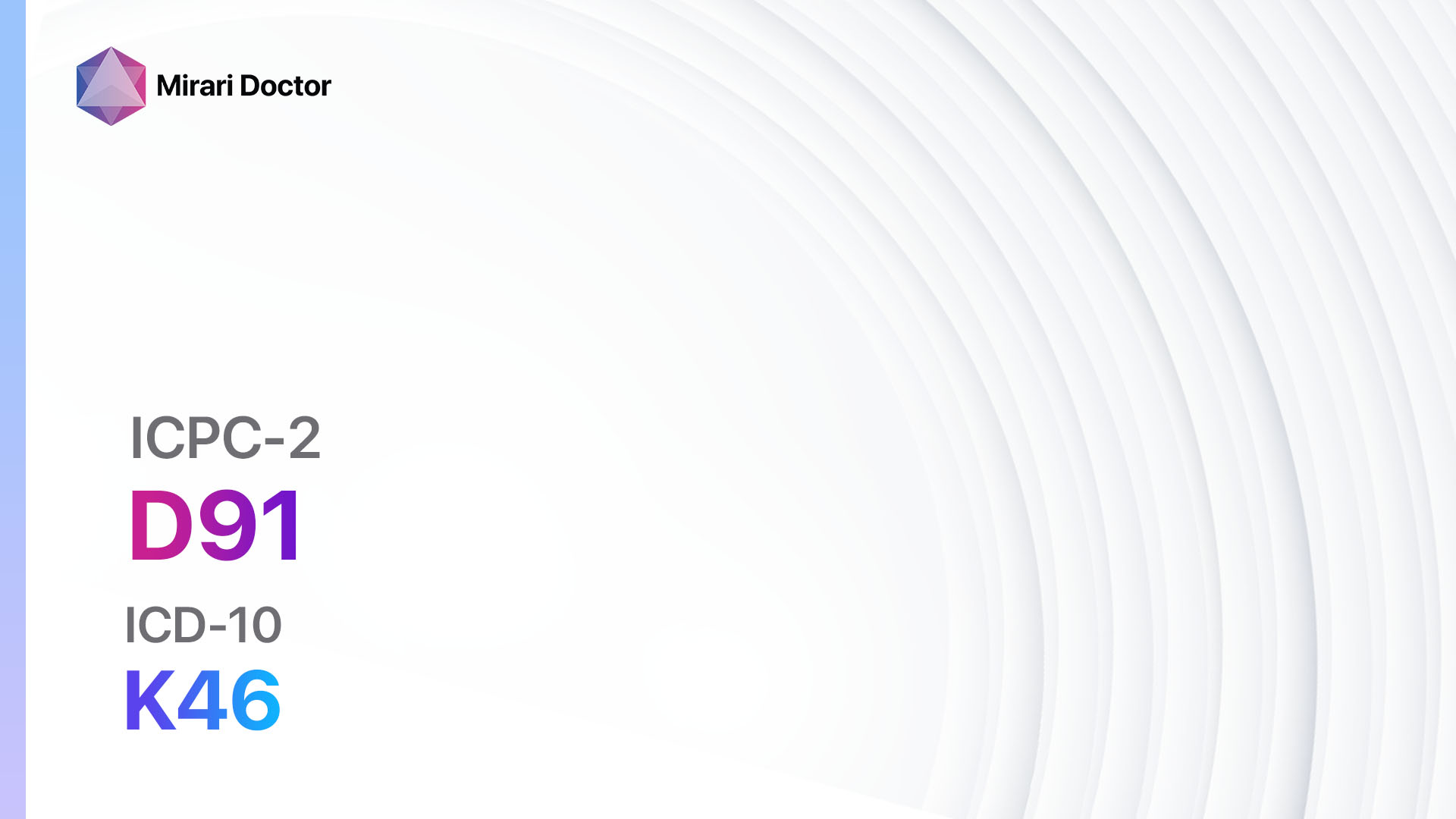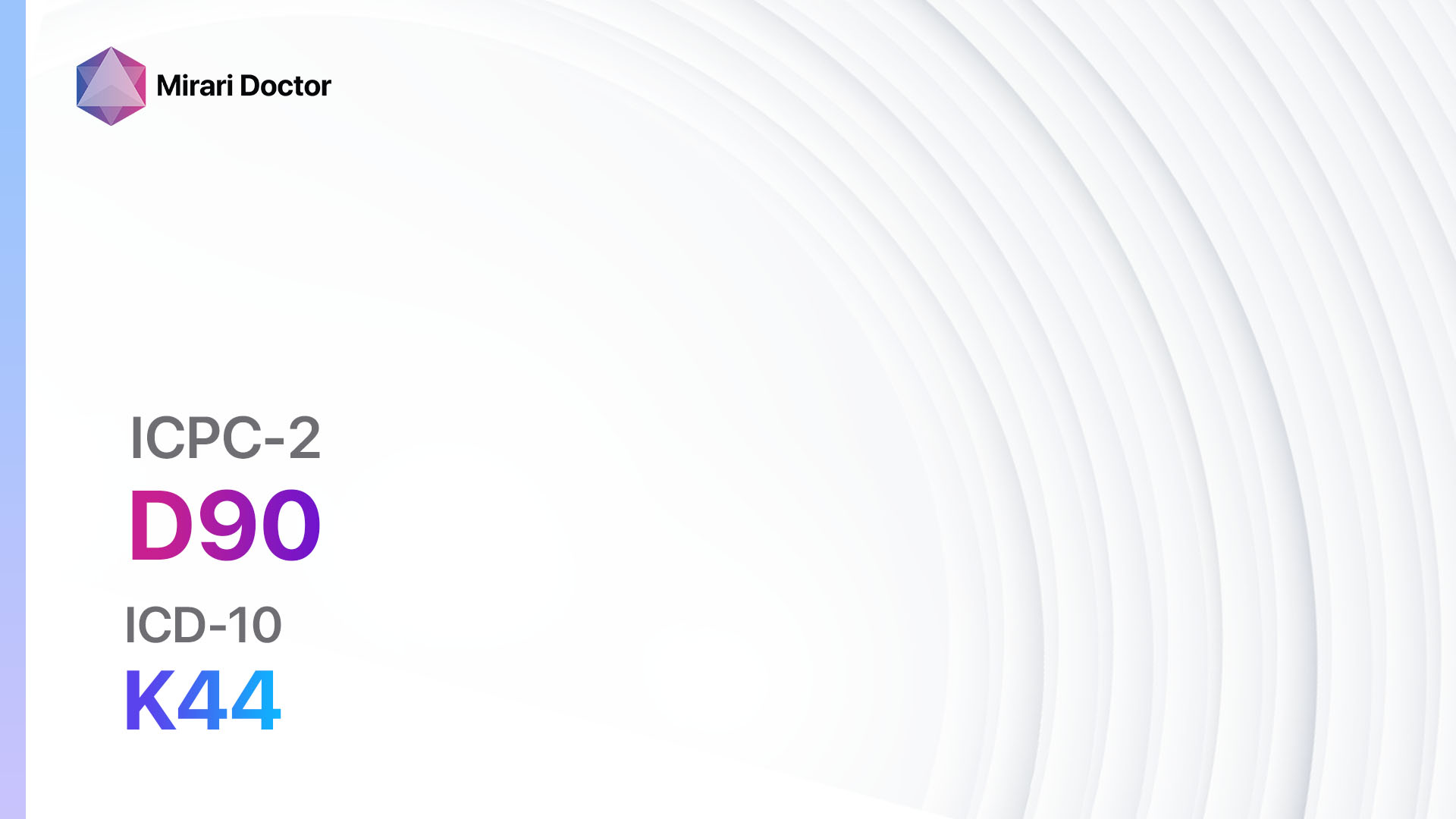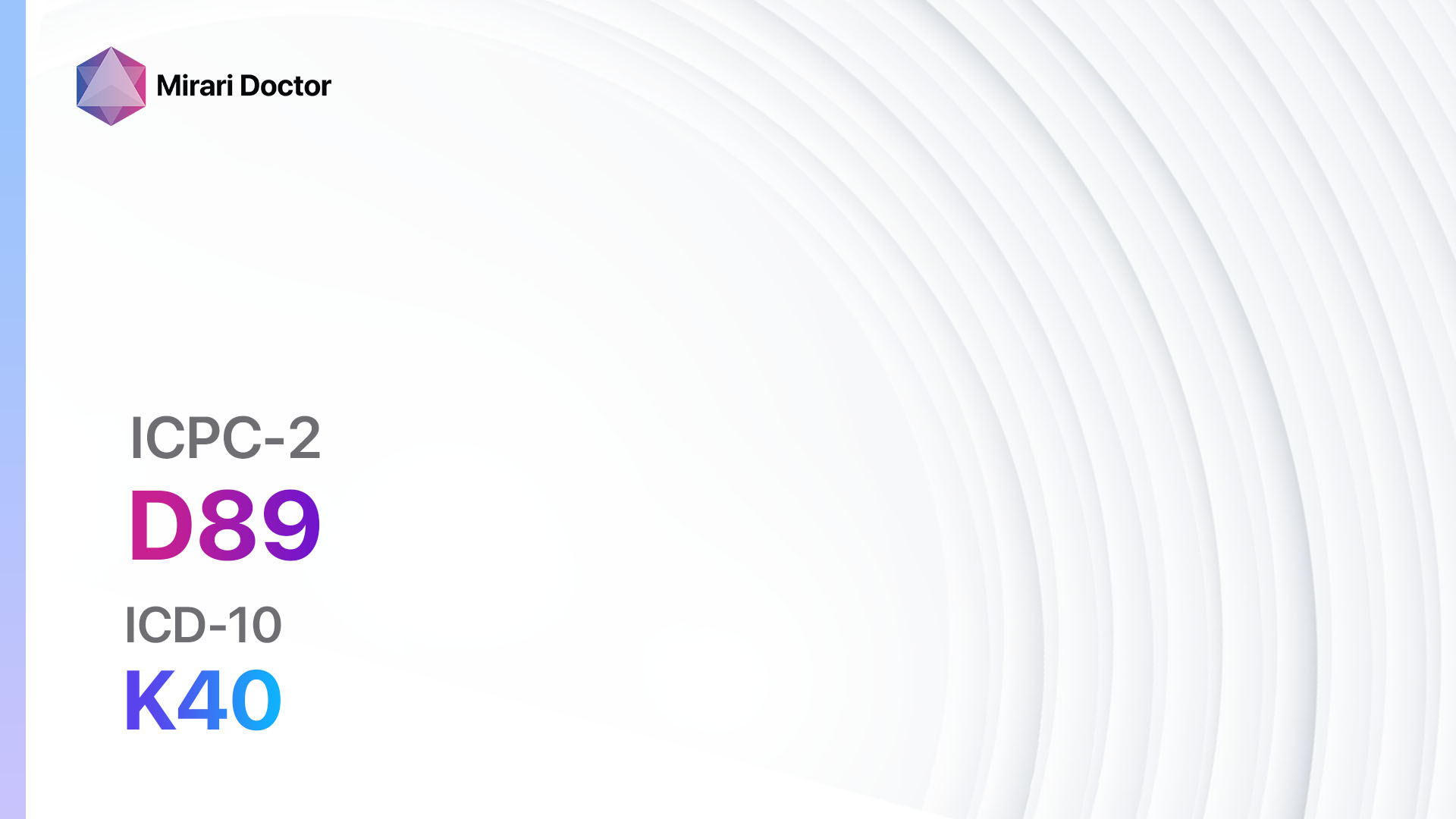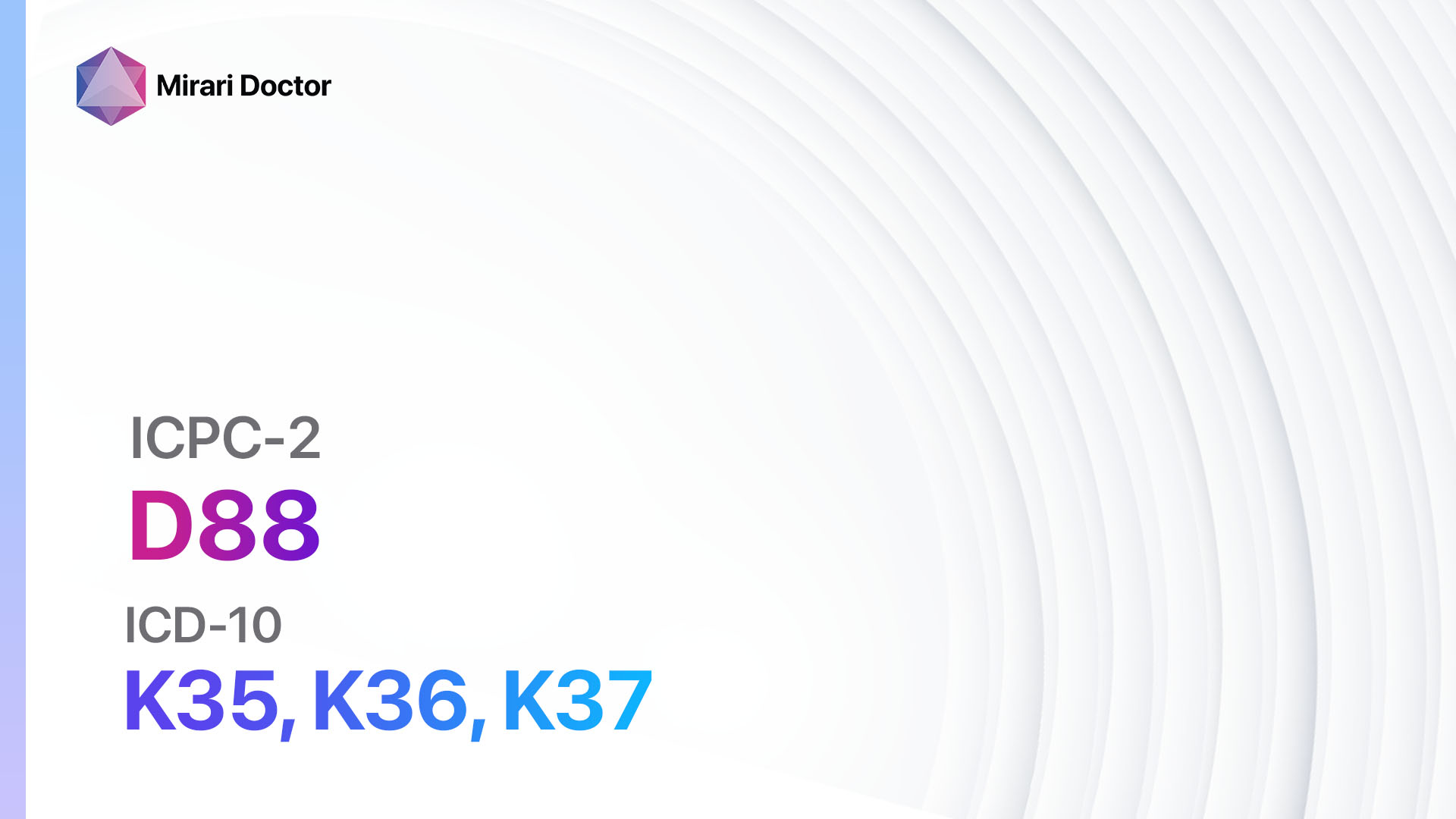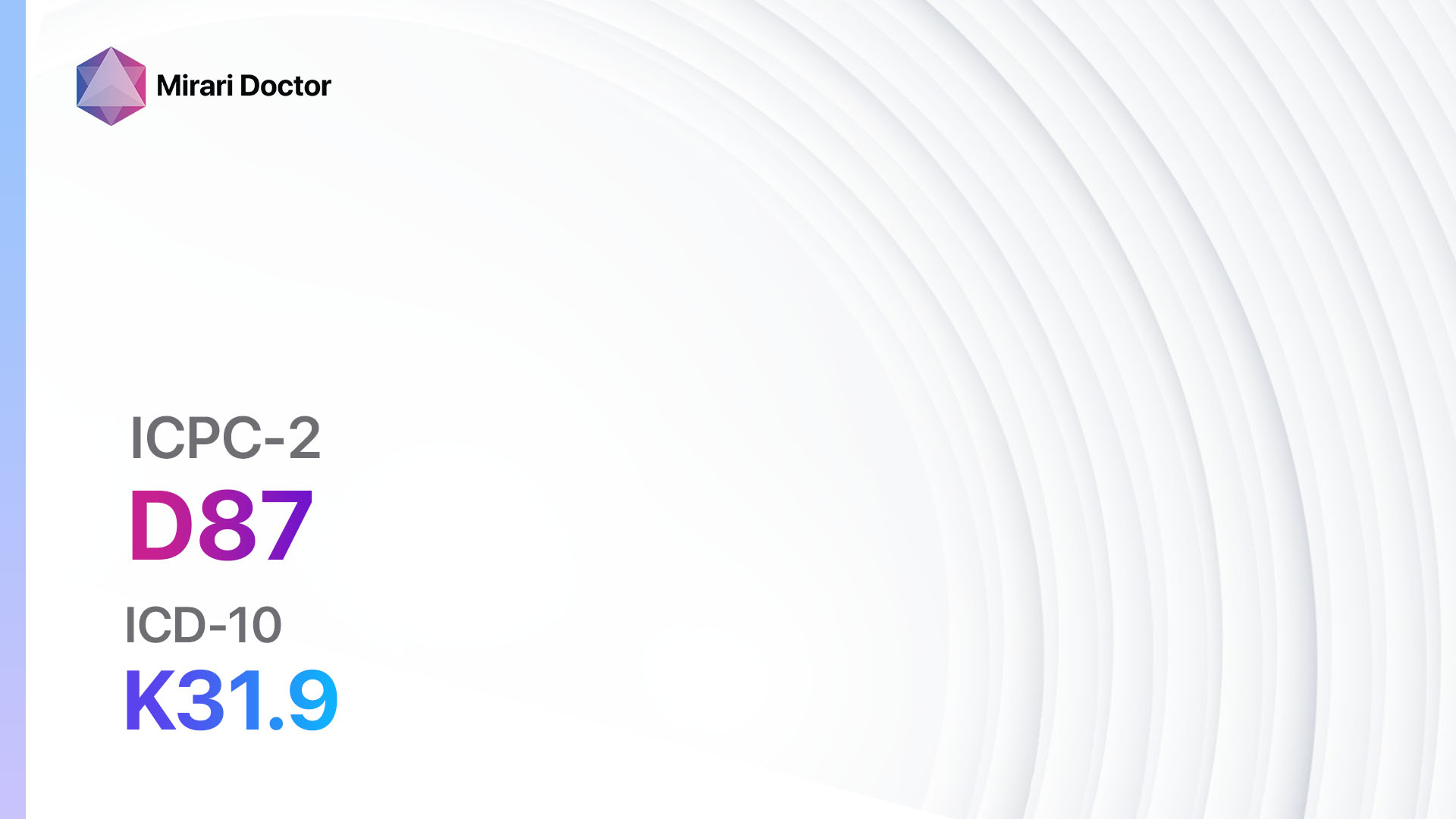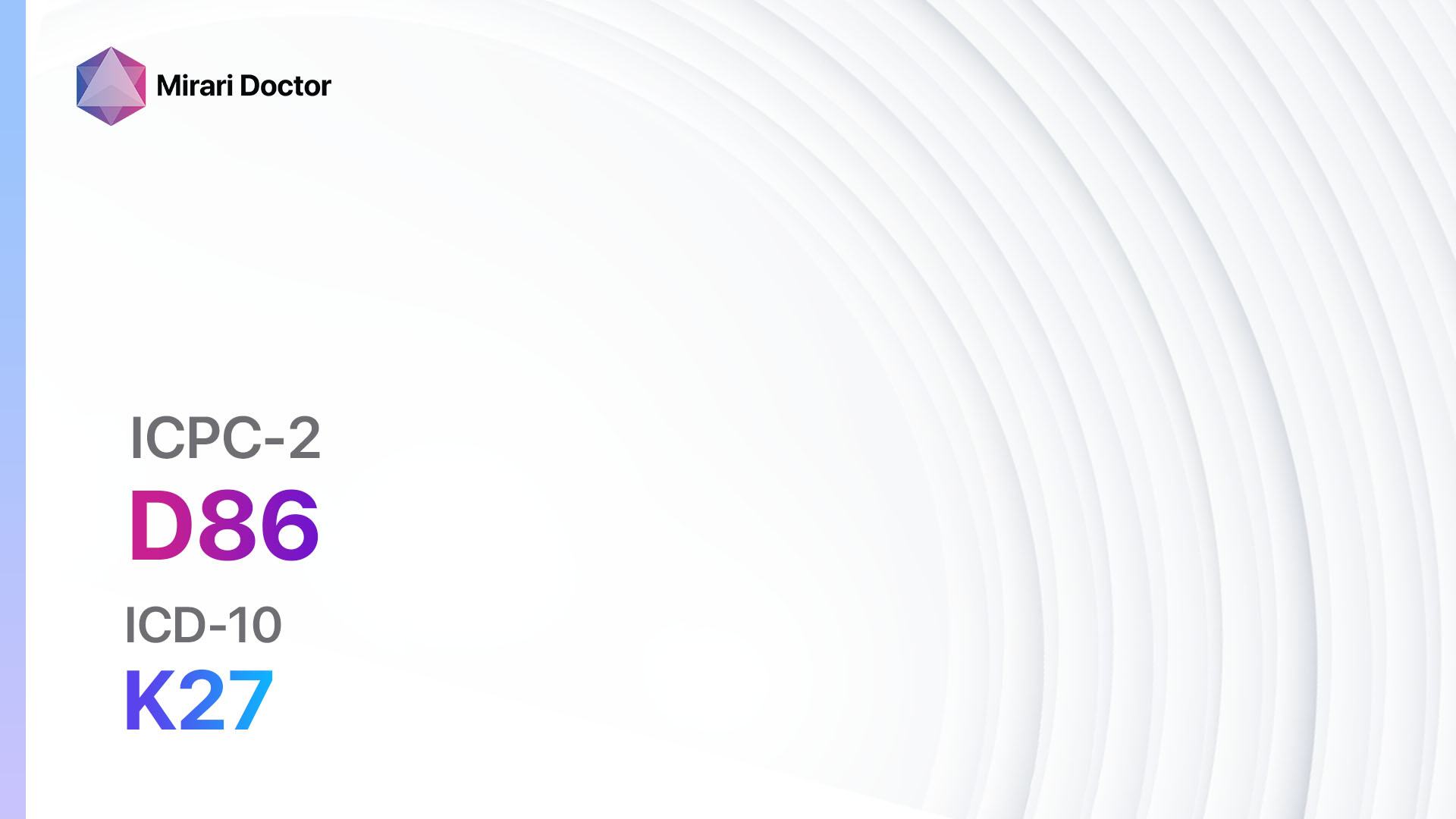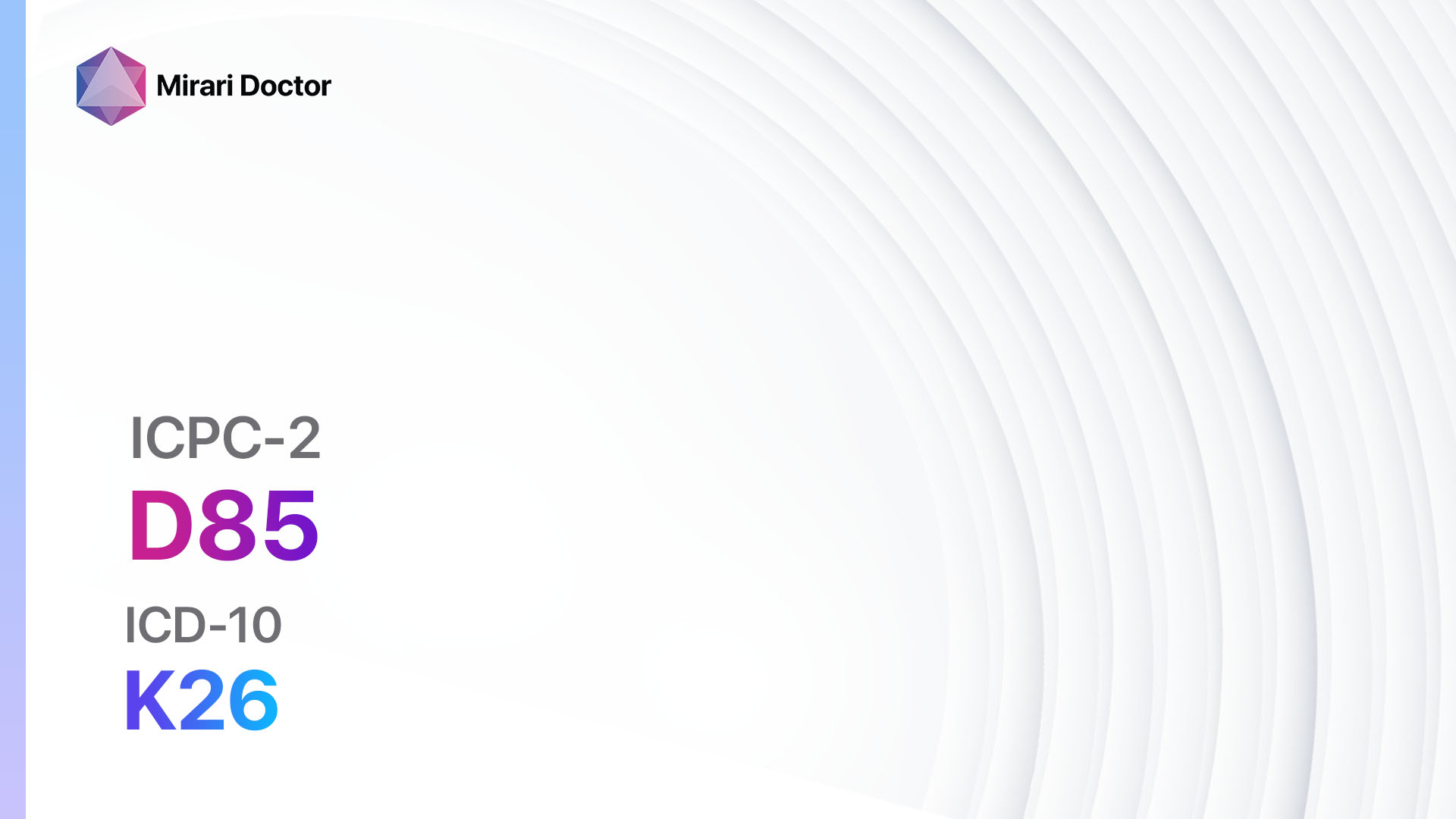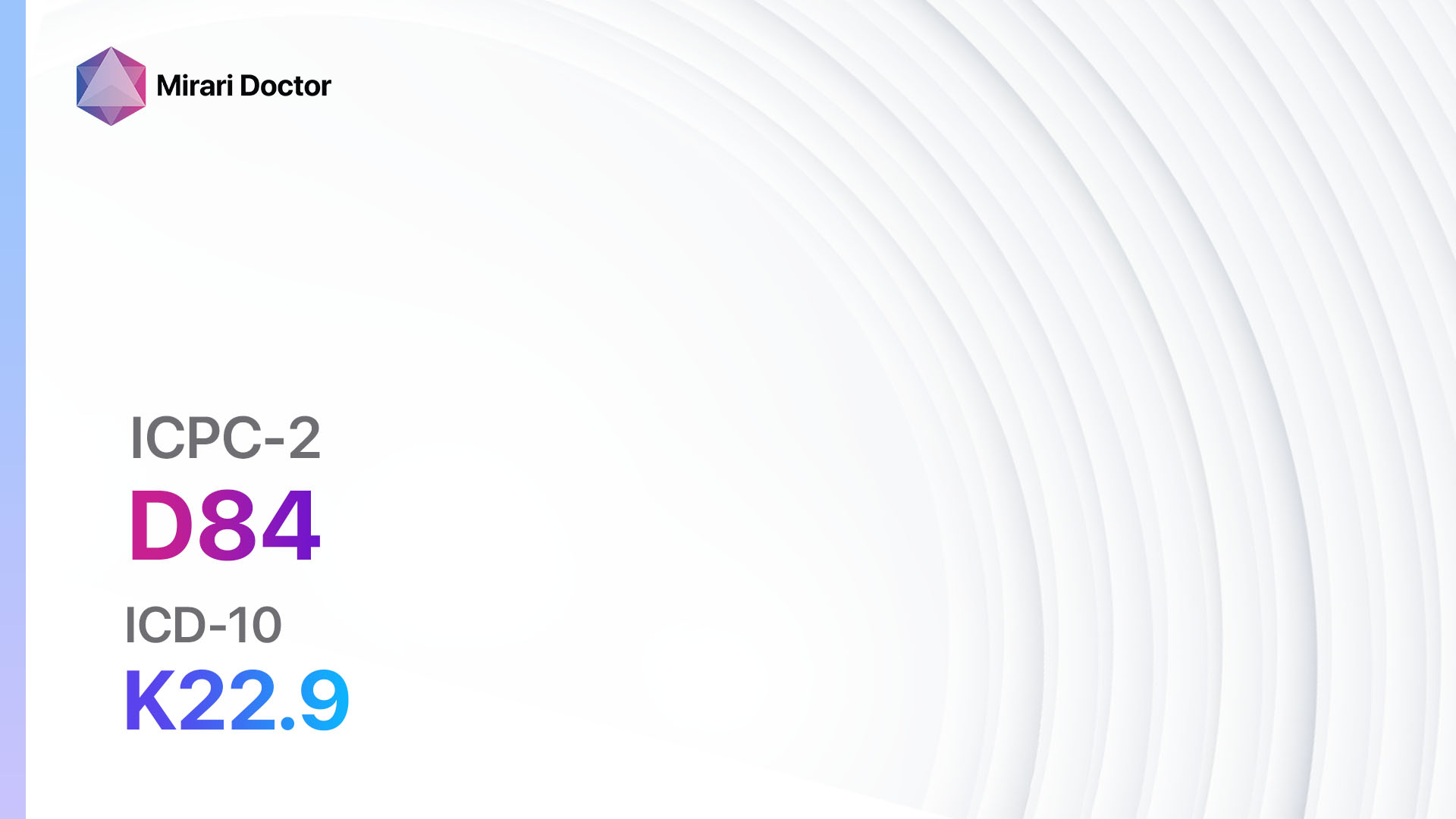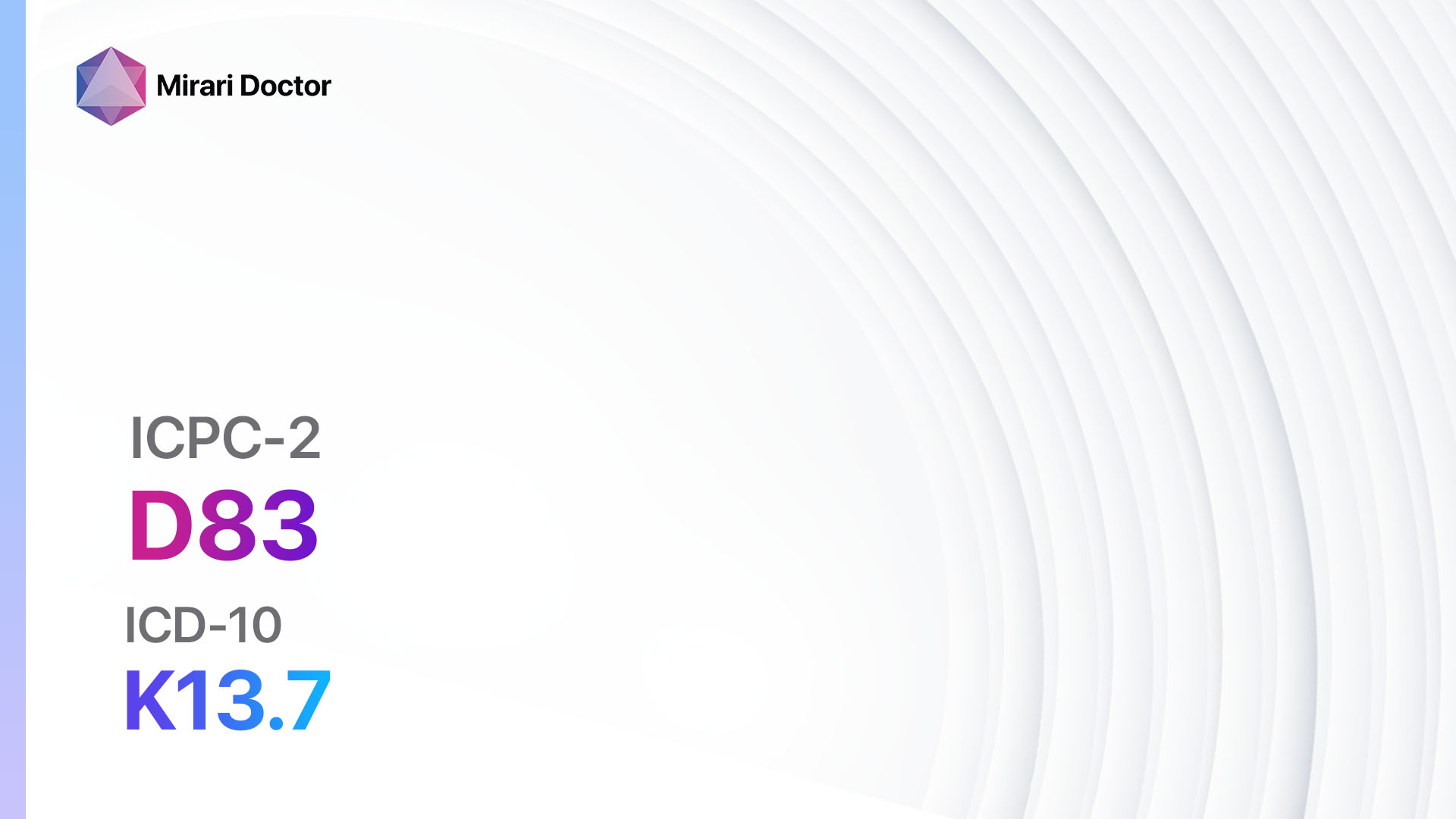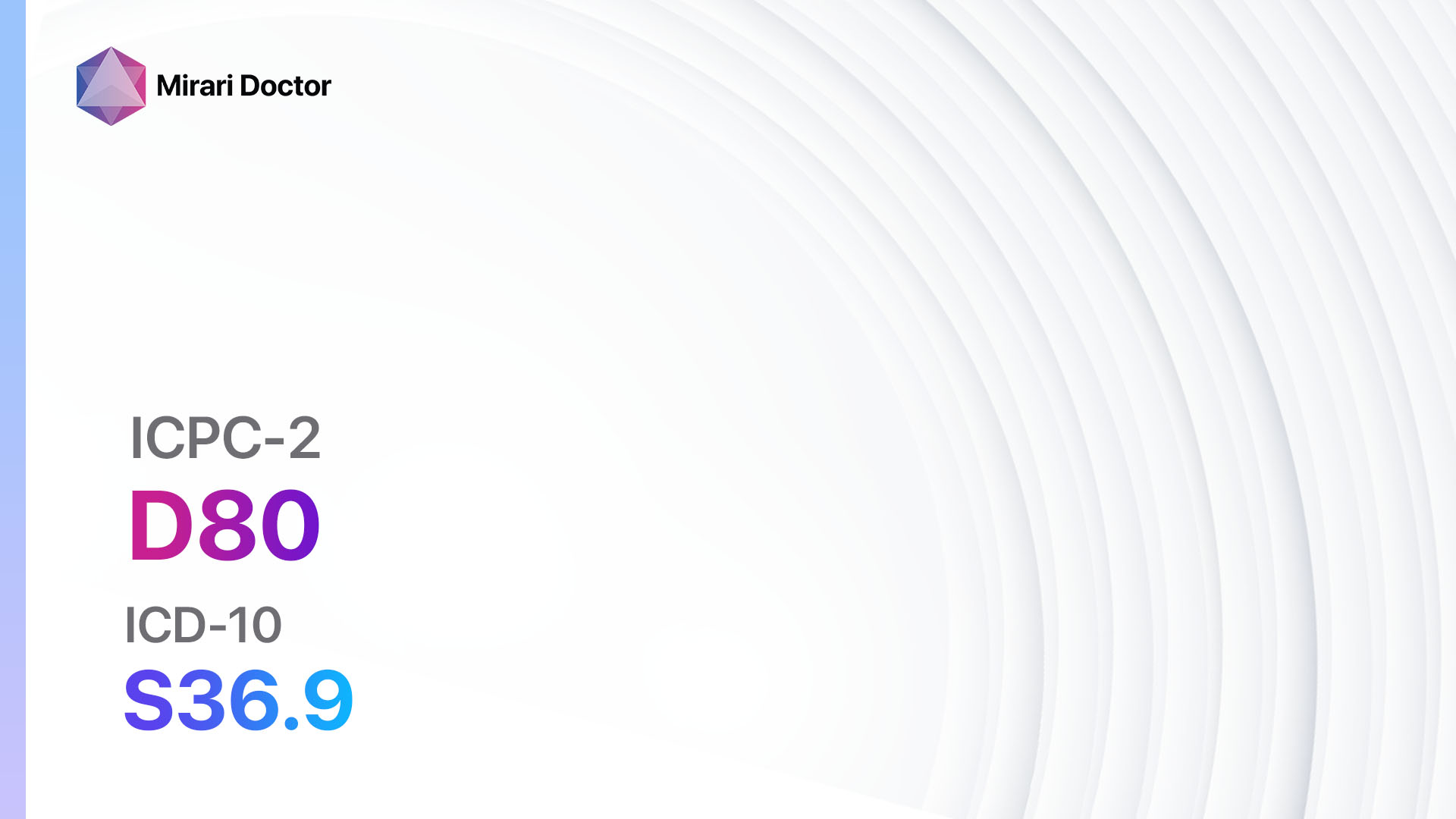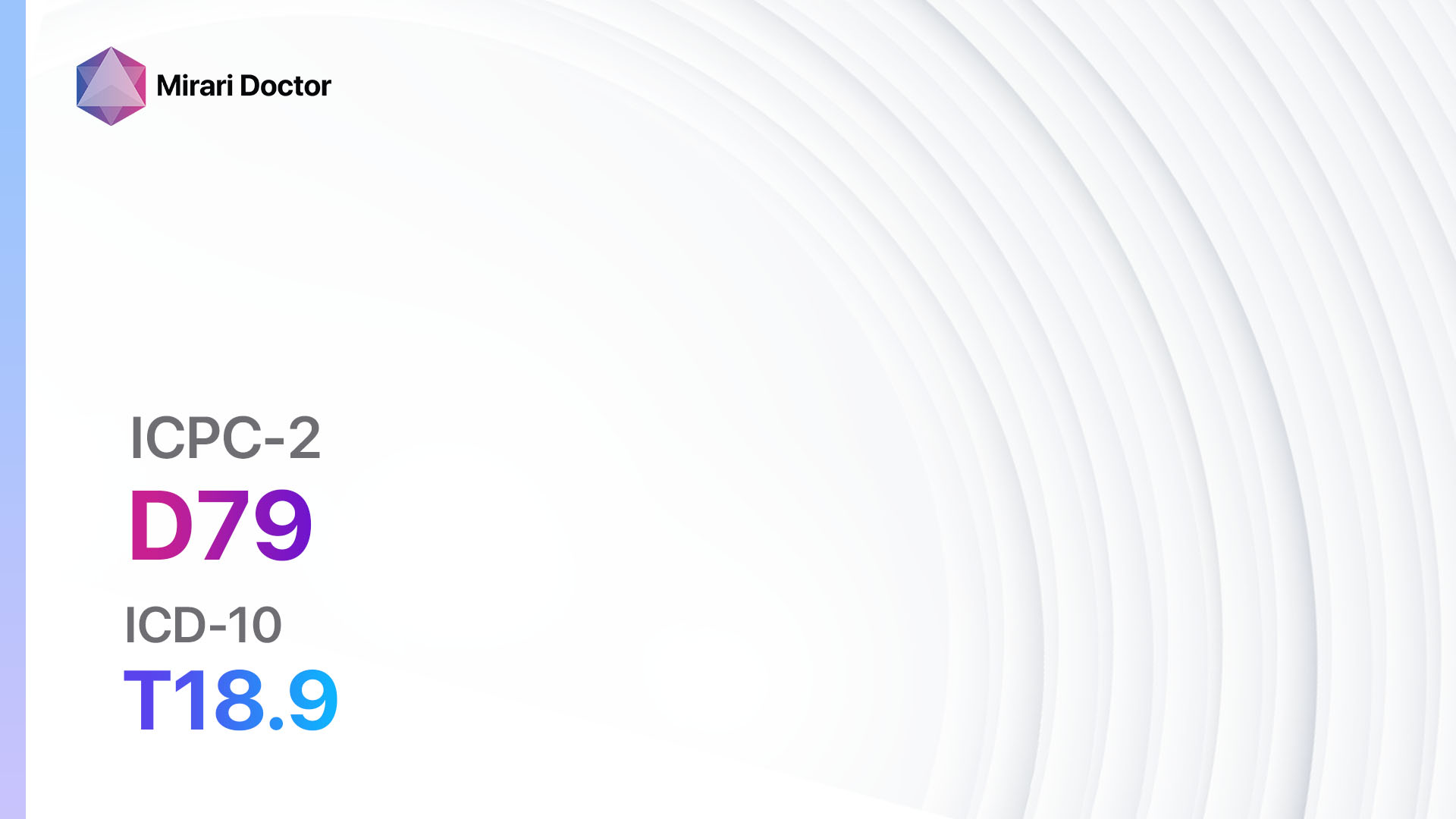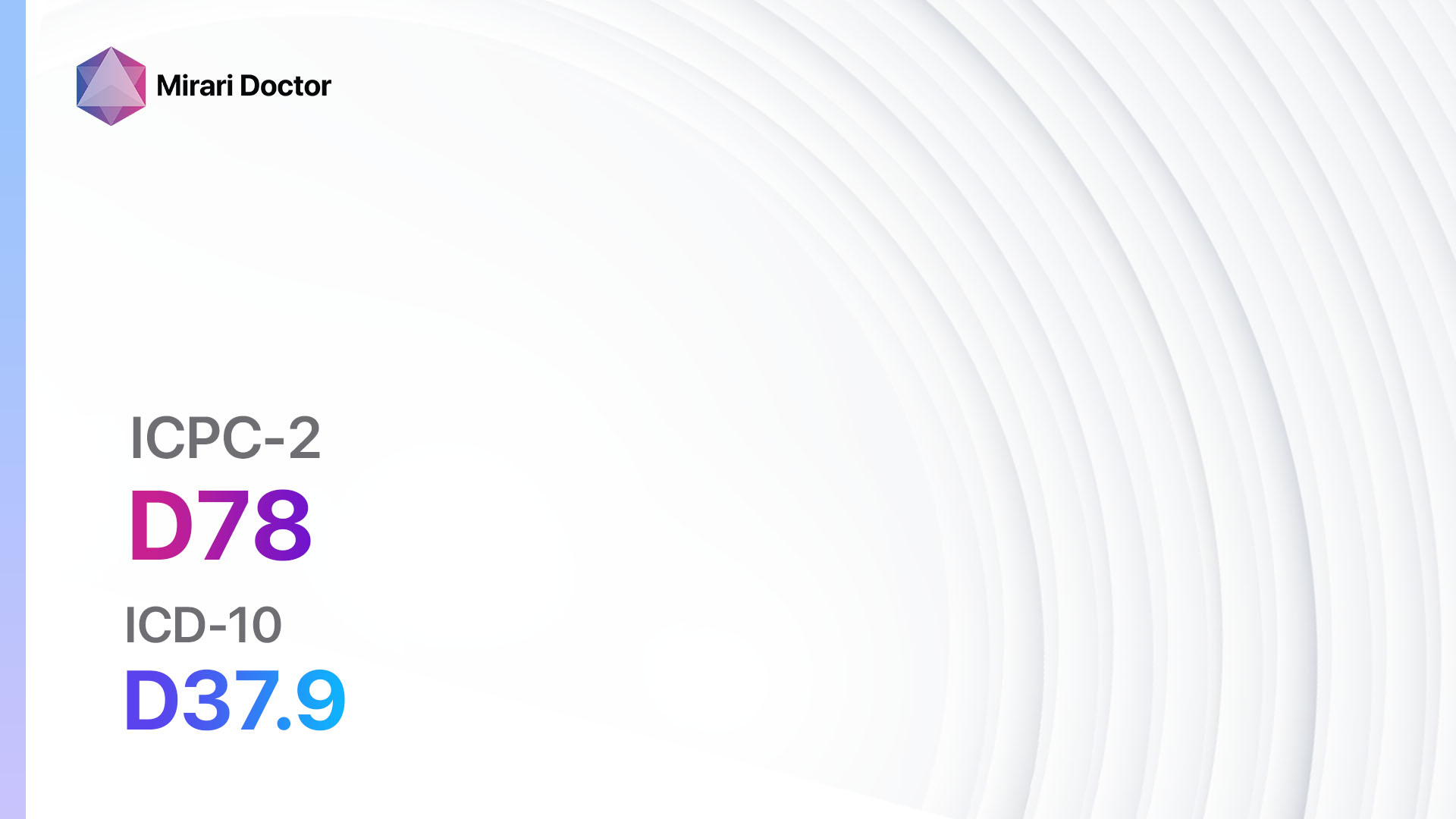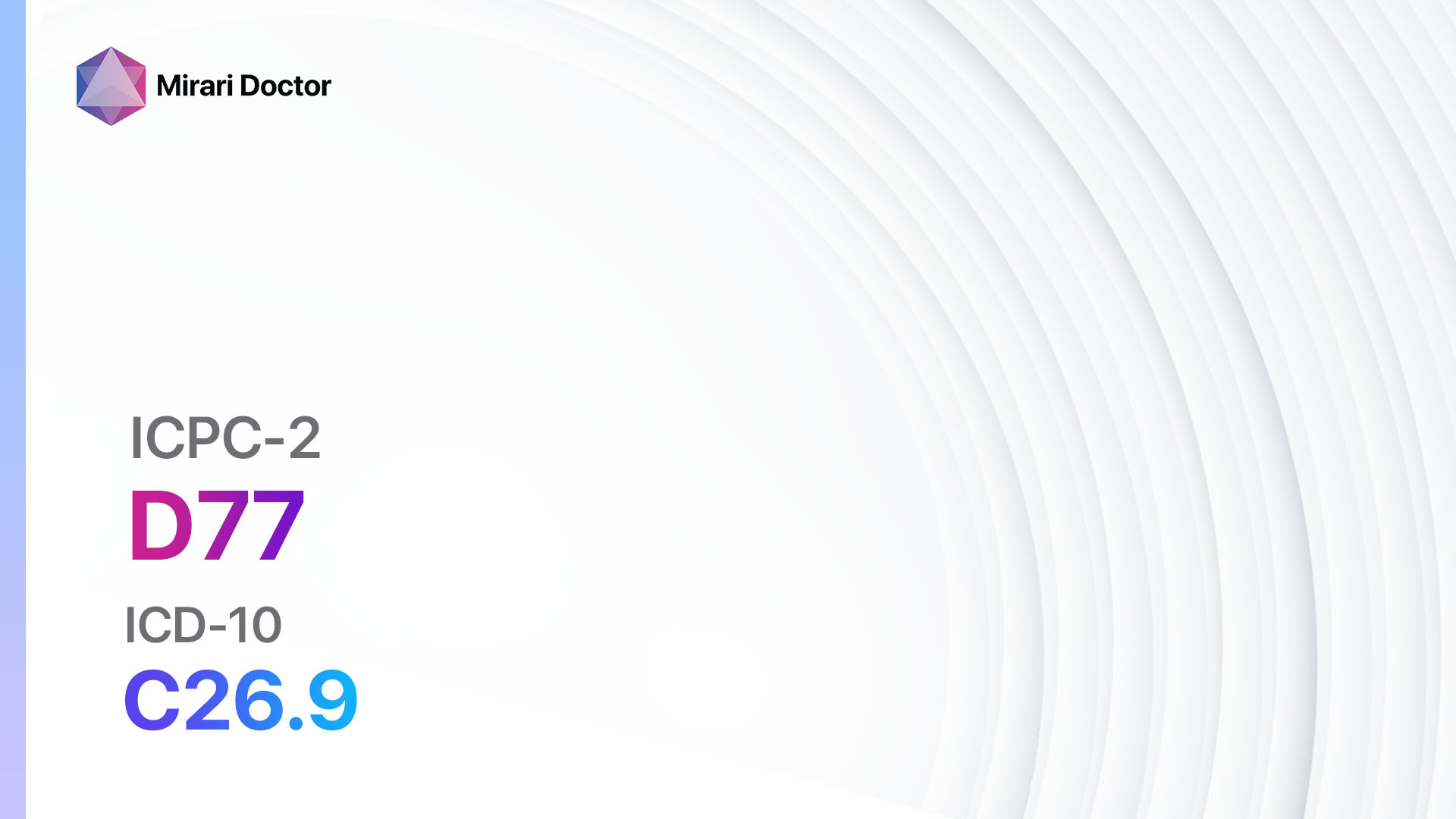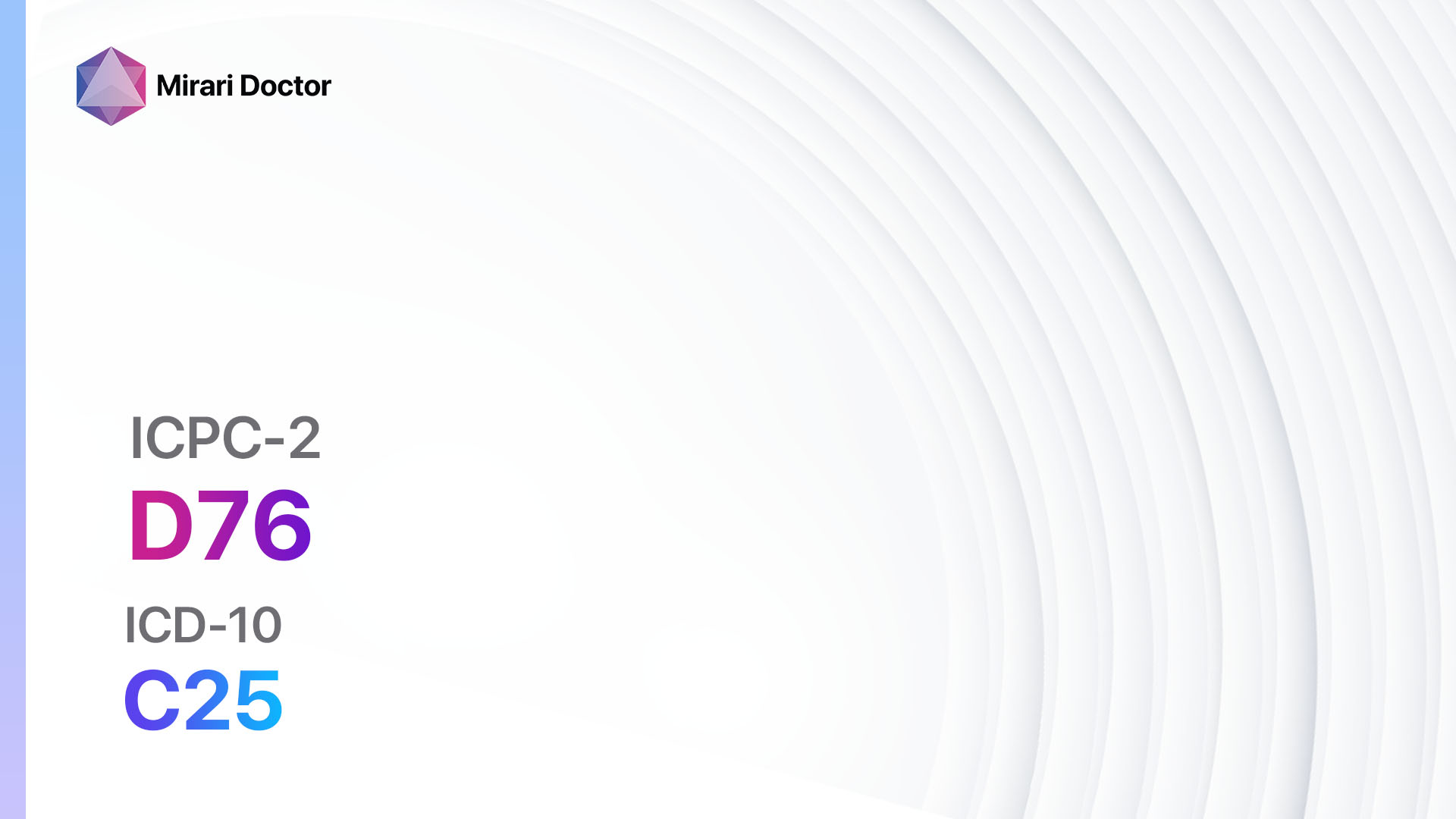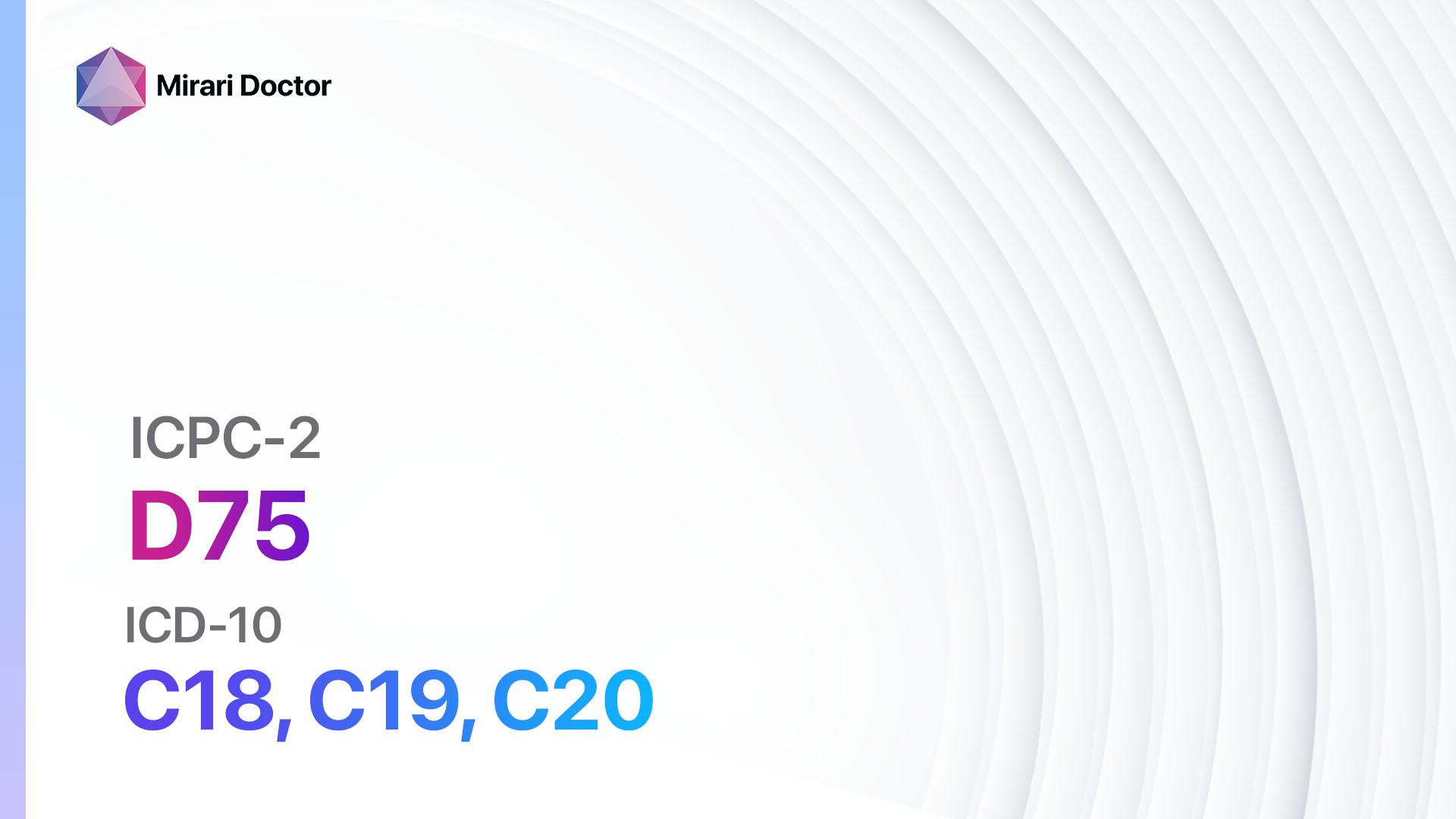
Introduction
Malignant neoplasm of the colon/rectum, also known as colorectal cancer, is a significant health condition that affects the large intestine and rectum. It is one of the most common types of cancer worldwide and can have serious consequences if not diagnosed and treated early[1]. The aim of this guide is to provide healthcare professionals with a comprehensive overview of the diagnostic steps, possible interventions, and patient education for this condition.
Codes
- ICPC-2 Code: D75 Malignant neoplasm colon/rectum
- ICD-10 Code: C18 Malignant neoplasm of colon, C19 Malignant neoplasm of rectosigmoid junction, C20 Malignant neoplasm of rectum[2]
Symptoms
- Abdominal pain: Patients may experience persistent abdominal discomfort or cramps[3].
- Changes in bowel habits: This can include diarrhea, constipation, or a change in the consistency of stool[4].
- Rectal bleeding: Blood in the stool or bleeding from the rectum is a common symptom[5].
- Unexplained weight loss: Patients may experience a significant and unexplained loss of weight[6].
- Fatigue: Generalized fatigue and weakness may be present[7].
Causes
- Age: The risk of developing colorectal cancer increases with age, with most cases occurring in individuals over 50 years old[8].
- Family history: A family history of colorectal cancer or certain genetic conditions, such as Lynch syndrome or familial adenomatous polyposis, can increase the risk[9].
- Personal history of polyps or inflammatory bowel disease: Individuals with a history of polyps in the colon or rectum or inflammatory bowel disease, such as Crohn’s disease or ulcerative colitis, are at a higher risk[10].
- Lifestyle factors: Certain lifestyle factors, such as a diet high in red and processed meats, low fiber intake, sedentary behavior, obesity, and smoking, can increase the risk.
Diagnostic Steps
Medical History
- Gather information about the patient’s risk factors, such as age, family history, and personal history of polyps or inflammatory bowel disease.
- Ask about the presence of symptoms, such as abdominal pain, changes in bowel habits, rectal bleeding, unexplained weight loss, and fatigue.
- Inquire about any relevant medical conditions or previous surgeries.
Physical Examination
- Perform a thorough physical examination, including a digital rectal examination, to assess for any abnormalities or signs of disease.
- Look for signs of anemia, such as pale skin or conjunctiva, which may indicate rectal bleeding.
- Palpate the abdomen for any masses or tenderness.
Laboratory Tests
- Complete blood count (CBC): To assess for anemia or other blood abnormalities.
- Liver function tests: To evaluate liver function and detect any liver involvement.
- Carcinoembryonic antigen (CEA) test: Elevated levels of CEA may indicate the presence of colorectal cancer, although it is not specific to this condition.
- Fecal occult blood test (FOBT): To detect the presence of blood in the stool, which may suggest colorectal cancer.
Diagnostic Imaging
- Colonoscopy: This is the gold standard for diagnosing colorectal cancer. It allows for direct visualization of the colon and rectum, and the ability to biopsy any suspicious lesions.
- Computed tomography (CT) scan: A CT scan can provide detailed images of the abdomen and pelvis, helping to determine the extent of the disease and identify any metastases.
- Magnetic resonance imaging (MRI): An MRI may be used to evaluate the rectum and surrounding structures in more detail, particularly in cases of rectal cancer.
- Chest X-ray: To assess for the presence of lung metastases.
Other Tests
- Genetic testing: In cases where there is a strong family history of colorectal cancer, genetic testing may be recommended to identify any inherited genetic mutations.
- Endorectal ultrasound: This test uses sound waves to create images of the rectum and nearby structures, helping to determine the depth of tumor invasion.
- Positron emission tomography (PET) scan: A PET scan can be used to detect the presence of cancer cells in other parts of the body, particularly in cases of advanced disease.
Follow-up and Patient Education
- Provide the patient with a clear explanation of the diagnosis and treatment plan.
- Discuss the importance of regular follow-up appointments and monitoring.
- Educate the patient about lifestyle modifications that can help reduce the risk of recurrence, such as maintaining a healthy weight, engaging in regular physical activity, and following a balanced diet.
- Offer emotional support and provide resources for counseling or support groups.
Possible Interventions
Traditional Interventions
Medications:
Top 5 drugs for Malignant neoplasm colon/rectum:
- Fluorouracil (5-FU):
- Cost: $100-$500 per cycle.
- Contraindications: Hypersensitivity to fluorouracil or any of its components.
- Side effects: Nausea, vomiting, diarrhea, fatigue.
- Severe side effects: Bone marrow suppression, cardiotoxicity.
- Drug interactions: Warfarin, phenytoin, leucovorin.
- Warning: Requires close monitoring of blood counts and liver function.
- Oxaliplatin:
- Cost: $1,000-$3,000 per cycle.
- Contraindications: Hypersensitivity to oxaliplatin or any of its components.
- Side effects: Peripheral neuropathy, nausea, vomiting.
- Severe side effects: Bone marrow suppression, allergic reactions.
- Drug interactions: None reported.
- Warning: Requires close monitoring of blood counts and kidney function.
- Irinotecan:
- Cost: $1,000-$3,000 per cycle.
- Contraindications: Hypersensitivity to irinotecan or any of its components.
- Side effects: Diarrhea, nausea, vomiting.
- Severe side effects: Bone marrow suppression, allergic reactions.
- Drug interactions: CYP3A4 inhibitors, CYP3A4 inducers.
- Warning: Requires close monitoring of blood counts and liver function.
- Capecitabine:
- Cost: $1,000-$3,000 per cycle.
- Contraindications: Hypersensitivity to capecitabine or any of its components.
- Side effects: Hand-foot syndrome, diarrhea, nausea.
- Severe side effects: Bone marrow suppression, cardiotoxicity.
- Drug interactions: Warfarin, phenytoin, leucovorin.
- Warning: Requires close monitoring of blood counts and liver function.
- Bevacizumab:
- Cost: $2,000-$5,000 per cycle.
- Contraindications: Hypersensitivity to bevacizumab or any of its components.
- Side effects: Hypertension, proteinuria, bleeding.
- Severe side effects: Gastrointestinal perforation, arterial thromboembolism.
- Drug interactions: None reported.
- Warning: Increased risk of bleeding and wound healing complications.
Alternative Drugs:
- Cetuximab: An epidermal growth factor receptor (EGFR) inhibitor used in combination with chemotherapy for certain types of colorectal cancer.
- Panitumumab: Another EGFR inhibitor used in combination with chemotherapy for certain types of colorectal cancer.
- Regorafenib: A multi-kinase inhibitor used for the treatment of metastatic colorectal cancer.
- Ramucirumab: A vascular endothelial growth factor receptor 2 (VEGFR2) inhibitor used in combination with chemotherapy for certain types of colorectal cancer.
- Trifluridine/tipiracil: An oral combination chemotherapy used for the treatment of metastatic colorectal cancer.
Surgical Procedures:
- Colectomy: Surgical removal of a portion or the entire colon affected by cancer. Cost: $20,000-$50,000.
- Rectal resection: Surgical removal of the rectum affected by cancer, often followed by colostomy or ileostomy. Cost: $20,000-$50,000.
- Chemotherapy port placement: Placement of a port under the skin to facilitate the administration of chemotherapy. Cost: $5,000-$10,000.
- Radiation therapy: The use of high-energy radiation to kill cancer cells or shrink tumors. Cost: $10,000-$30,000.
Alternative Interventions
- Acupuncture: May help manage treatment-related side effects and improve overall well-being. Cost: $60-$120 per session.
- Herbal supplements: Some herbal supplements, such as curcumin or green tea extract, may have potential benefits in reducing inflammation and preventing cancer recurrence. Cost: Varies depending on the specific supplement.
- Mind-body techniques: Practices such as meditation, yoga, or tai chi can help reduce stress and improve quality of life. Cost: Varies depending on the specific practice and location.
- Dietary modifications: A diet rich in fruits, vegetables, whole grains, and lean proteins may help support overall health and reduce the risk of cancer recurrence. Cost: Varies depending on individual food choices.
Lifestyle Interventions
- Regular exercise: Engaging in regular physical activity, such as walking, swimming, or cycling, can help improve overall health and reduce the risk of cancer recurrence. Cost: Varies depending on individual preferences and access to exercise facilities.
- Smoking cessation: Quitting smoking can have numerous health benefits, including a reduced risk of cancer recurrence. Cost: Varies depending on individual smoking cessation methods.
- Stress management: Techniques such as deep breathing exercises, mindfulness, or therapy can help individuals manage stress and improve overall well-being. Cost: Varies depending on the specific technique or therapy chosen.
- Weight management: Maintaining a healthy weight through a balanced diet and regular exercise can help reduce the risk of cancer recurrence. Cost: Varies depending on individual food choices and access to exercise facilities.
It is important to note that the cost ranges provided are approximate and may vary depending on the location and availability of the interventions.
Mirari Cold Plasma Alternative Intervention
Understanding Mirari Cold Plasma
- Safe and Non-Invasive Treatment: Mirari Cold Plasma is a safe and non-invasive treatment option for various skin conditions. It does not require incisions, minimizing the risk of scarring, bleeding, or tissue damage.
- Efficient Extraction of Foreign Bodies: Mirari Cold Plasma facilitates the removal of foreign bodies from the skin by degrading and dissociating organic matter, allowing easier access and extraction.
- Pain Reduction and Comfort: Mirari Cold Plasma has a local analgesic effect, providing pain relief during the treatment, making it more comfortable for the patient.
- Reduced Risk of Infection: Mirari Cold Plasma has antimicrobial properties, effectively killing bacteria and reducing the risk of infection.
- Accelerated Healing and Minimal Scarring: Mirari Cold Plasma stimulates wound healing and tissue regeneration, reducing healing time and minimizing the formation of scars.
Mirari Cold Plasma Prescription
Video instructions for using Mirari Cold Plasma Device – D75 Malignant neoplasm colon/rectum (ICD-10:C18, C19, C20)
| Mild | Moderate | Severe |
| Mode setting: 1 (Infection) Location: 0 (Localized) Morning: 15 minutes, Evening: 15 minutes |
Mode setting: 1 (Infection) Location: 0 (Localized) Morning: 30 minutes, Lunch: 30 minutes, Evening: 30 minutes |
Mode setting: 1 (Infection) Location: 0 (Localized) Morning: 30 minutes, Lunch: 30 minutes, Evening: 30 minutes |
| Mode setting: 2 (Wound Healing) Location: 0 (Localized) Morning: 15 minutes, Evening: 15 minutes |
Mode setting: 2 (Wound Healing) Location: 0 (Localized) Morning: 30 minutes, Lunch: 30 minutes, Evening: 30 minutes |
Mode setting: 2 (Wound Healing) Location: 0 (Localized) Morning: 30 minutes, Lunch: 30 minutes, Evening: 30 minutes |
| Mode setting: 6 (Liver/Kidney Therapy) Location: 3 (Kidney, Liver & Spleen) Morning: 15 minutes, Evening: 15 minutes |
Mode setting: 6 (Liver/Kidney Therapy) Location: 3 (Kidney, Liver & Spleen) Morning: 30 minutes, Lunch: 30 minutes, Evening: 30 minutes |
Mode setting: 6 (Liver/Kidney Therapy) Location: 3 (Kidney, Liver & Spleen) Morning: 30 minutes, Lunch: 30 minutes, Evening: 30 minutes |
| Mode setting: 7 (Immunotherapy) Location: 4 (Heart, Bile & Pancreas) Morning: 15 minutes, Evening: 15 minutes |
Mode setting: 7 (Immunotherapy) Location: 4 (Heart, Bile & Pancreas) Morning: 30 minutes, Lunch: 30 minutes, Evening: 30 minutes |
Mode setting: 7 (Immunotherapy) Location: 4 (Heart, Bile & Pancreas) Morning: 30 minutes, Lunch: 30 minutes, Evening: 30 minutes |
| Total Morning: 60 minutes approx. $10 USD, Evening: 60 minutes approx. $10 USD |
Total Morning: 120 minutes approx. $20 USD, Lunch: 120 minutes approx. $20 USD, Evening: 120 minutes approx. $20 USD, |
Total Morning: 120 minutes approx. $20 USD, Lunch: 120 minutes approx. $20 USD, Evening: 120 minutes approx. $20 USD, |
| Usual treatment for 7-60 days approx. $140 USD – $1200 USD | Usual treatment for 6-8 weeks approx. $2,520 USD – $3,360 USD |
Usual treatment for 3-6 months approx. $5,400 USD – $10,800 USD
|
 |
|
Use the Mirari Cold Plasma device to treat Malignant neoplasm colon/rectum effectively.
WARNING: MIRARI COLD PLASMA IS DESIGNED FOR THE HUMAN BODY WITHOUT ANY ARTIFICIAL OR THIRD PARTY PRODUCTS. USE OF OTHER PRODUCTS IN COMBINATION WITH MIRARI COLD PLASMA MAY CAUSE UNPREDICTABLE EFFECTS, HARM OR INJURY. PLEASE CONSULT A MEDICAL PROFESSIONAL BEFORE COMBINING ANY OTHER PRODUCTS WITH USE OF MIRARI.
Step 1: Cleanse the Skin
- Start by cleaning the affected area of the skin with a gentle cleanser or mild soap and water. Gently pat the area dry with a clean towel.
Step 2: Prepare the Mirari Cold Plasma device
- Ensure that the Mirari Cold Plasma device is fully charged or has fresh batteries as per the manufacturer’s instructions. Make sure the device is clean and in good working condition.
- Switch on the Mirari device using the power button or by following the specific instructions provided with the device.
- Some Mirari devices may have adjustable settings for intensity or treatment duration. Follow the manufacturer’s instructions to select the appropriate settings based on your needs and the recommended guidelines.
Step 3: Apply the Device
- Place the Mirari device in direct contact with the affected area of the skin. Gently glide or hold the device over the skin surface, ensuring even coverage of the area experiencing.
- Slowly move the Mirari device in a circular motion or follow a specific pattern as indicated in the user manual. This helps ensure thorough treatment coverage.
Step 4: Monitor and Assess:
- Keep track of your progress and evaluate the effectiveness of the Mirari device in managing your Malignant neoplasm colon/rectum. If you have any concerns or notice any adverse reactions, consult with your health care professional.
Note
This guide is for informational purposes only and should not replace the advice of a medical professional. Always consult with your healthcare provider or a qualified medical professional for personal advice, diagnosis, or treatment. Do not solely rely on the information presented here for decisions about your health. Use of this information is at your own risk. The authors of this guide, nor any associated entities or platforms, are not responsible for any potential adverse effects or outcomes based on the content.
Mirari Cold Plasma System Disclaimer
- Purpose: The Mirari Cold Plasma System is a Class 2 medical device designed for use by trained healthcare professionals. It is registered for use in Thailand and Vietnam. It is not intended for use outside of these locations.
- Informational Use: The content and information provided with the device are for educational and informational purposes only. They are not a substitute for professional medical advice or care.
- Variable Outcomes: While the device is approved for specific uses, individual outcomes can differ. We do not assert or guarantee specific medical outcomes.
- Consultation: Prior to utilizing the device or making decisions based on its content, it is essential to consult with a Certified Mirari Tele-Therapist and your medical healthcare provider regarding specific protocols.
- Liability: By using this device, users are acknowledging and accepting all potential risks. Neither the manufacturer nor the distributor will be held accountable for any adverse reactions, injuries, or damages stemming from its use.
- Geographical Availability: This device has received approval for designated purposes by the Thai and Vietnam FDA. As of now, outside of Thailand and Vietnam, the Mirari Cold Plasma System is not available for purchase or use.
References
- Siegel, R. L., Miller, K. D., Fuchs, H. E., & Jemal, A. (2022). Cancer statistics, 2022. CA: A Cancer Journal for Clinicians, 72(1), 7-33.
- World Health Organization. (2022). International Statistical Classification of Diseases and Related Health Problems (ICD-10). Retrieved from https://icd.who.int/browse10/2022/en
- Tong, G. J., Hendifar, A. E., Tong, S. Y., Wu, C. S., Lau, J., Chak, A., … & Melstrom, L. G. (2018). Antiemetic medication use in patients with advanced colorectal cancer: a national comprehensive cancer network oncology patient wellness study. Journal of Clinical Oncology, 36(4_suppl), 642-642.
- Siegel, R. L., Miller, K. D., Goding Sauer, A., Fedewa, S. A., Butterly, L. F., Anderson, J. C., … & Jemal, A. (2020). Colorectal cancer statistics, 2020. CA: A Cancer Journal for Clinicians, 70(3), 145-164.
- Kuipers, E. J., Grady, W. M., Lieberman, D., Seufferlein, T., Sung, J. J., Boelens, P. G., … & Watanabe, T. (2015). Colorectal cancer. Nature Reviews Disease Primers, 1(1), 1-25.
- Rahman, Rubayat ; Schmaltz, Chester ; Jackson, Christian S. ; Simoes, Eduardo J. ; Jackson‐Thompson, Jeannette ; Ibdah, Jamal A. (2015). Increased risk for colorectal cancer under age 50 in racial and ethnic minorities living in the United States. DOI: 10.1002/cam4.560
- Sadeghi, Mohammad Reza ; Jeddi, Farhad ; Soozangar, Narges ; Somi, Mohammad Hossein ; Shirmohamadi, Masoud ; Khaze, Vahid ; Samadi, Nasser (2018). Nrf2/P–glycoprotein axis is associated with clinicopathological characteristics in colorectal cancer. DOI: 10.1016/j.biopha.2018.05.062
- Xia, Yu ; Tang, Guoyi ; Guo, Min ; Xu, Tiantian ; Chen, Haiyang ; Lin, Zhengfang ; Li, Yinghua ; Chen, Yi ; Zhu, Bing ; Liu, Hongsheng ; Cao, Jie (2020). Silencing KLK12 expression via RGDfC-decorated selenium nanoparticles for the treatment of colorectal cancer in vitro and in vivo. DOI: 10.1016/j.msec.2019.110594
- LIEVRE, Astrid ; CHAPUSOT, Caroline ; BOUVIER, Anne-Marie ; ZINZINDOHOUE, Franck ; PIARD, Francoise ; ROIGNOT, Patrick ; ARNOULD, Laurent ; BEAUNE, Philippe ; FAIVRE, Jean ; LAURENT-PUIG, Pierre (2005). Clinical Value of Mitochondrial Mutations in Colorectal Cancer. DOI: 10.1200/JCO.2005.07.044
- PRENEN, Hans ; DE SCHUTTER, Jef ; JACOBS, Bart ; DE ROOCK, Wendy ; BIESMANS, Bart ; CLAES, Bart ; LAMBRECHTS, Diether ; VAN CUTSEM, Eric ; TEJPAR, Sabine (2009). PIK3CA Mutations Are Not a Major Determinant of Resistance to the Epidermal Growth Factor Receptor Inhibitor Cetuximab in Metastatic Colorectal Cancer. DOI: 10.1158/1078-0432.CCR-08-2961
Related articles
Made in USA


